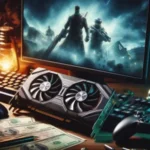Gaming laptops are powerful machines designed to deliver stunning graphics and immersive gameplay, but they can also generate a significant amount of heat during those intense gaming sessions.
As the temperature rises, performance can suffer, leading to lag and potential long-term damage to your beloved device. But fear not! In this post, we’ll explore the top tips to keep your gaming laptop cool and performing at its best, ensuring you can enjoy marathon gaming sessions without worrying about overheating. From choosing the right cooling accessories and optimizing your settings to maintaining proper airflow and utilizing effective cleaning techniques, we’ve got you covered. Say goodbye to those heat-induced game interruptions and hello to smooth, uninterrupted gameplay with our essential strategies to beat the heat while you play!
1. Understanding the Importance of Keeping Your Laptop Cool
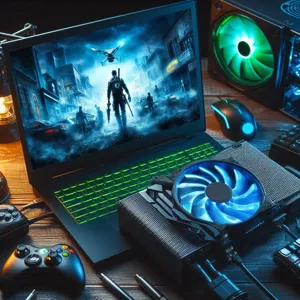
In the world of gaming, performance is everything. But no matter how powerful your gaming laptop is, overheating can swiftly bring your epic gaming sessions to a grinding halt. Understanding the importance of keeping your laptop cool is crucial not only for maintaining peak performance but also for prolonging the lifespan of your device.
When your laptop overheats, its internal components—like the CPU and GPU—can throttle down their performance to reduce heat output, resulting in laggy gameplay and stuttering frames that can ruin critical moments in your favorite titles. Additionally, excessive heat can lead to permanent damage over time, affecting the health of your laptop and necessitating costly repairs or even replacement.
Moreover, the cooling system of a gaming laptop is often one of its most vital features. High-quality cooling solutions, such as efficient fans and thermal paste, are engineered to dissipate heat effectively. However, these systems can become less effective over time due to dust buildup and wear. Keeping your laptop cool not only ensures that it runs smoothly during intense gaming marathons but also helps maintain its overall performance and reliability long after those first exhilarating sessions.
In essence, understanding the importance of keeping your laptop cool is about more than just avoiding discomfort—it’s about ensuring your gaming experience remains exhilarating, uninterrupted, and enjoyable for years to come. So, let’s explore some practical tips to help you beat the heat while you play!
2. Signs Your Gaming Laptop is Overheating
Recognizing the signs that your gaming laptop is overheating is crucial to maintaining its performance and longevity. As you dive into intense gaming sessions, keep an eye out for several indicators that suggest your device is struggling to keep its cool.
One of the most noticeable signs is a significant increase in fan noise. If your laptop’s cooling fans seem to be working overtime, producing a persistent whirring sound or audible whines, it’s a clear indication that the internal temperatures are rising. Another symptom to watch for is an unusually hot exterior. If the laptop’s surface feels excessively warm—particularly around the vents or the bottom of the device—this is a sign that the heat isn’t dissipating properly.
Additionally, you may experience performance drops or lag during gameplay. If your once-smooth graphics suddenly stutter or you encounter unexpected frame drops, your laptop might be throttling its performance to prevent overheating. Crashes or unexpected shutdowns can also occur if the temperature reaches critical levels, leading to potential data loss and hardware damage.
Pay attention to warning messages as well. Many gaming laptops come equipped with built-in temperature monitoring software that alerts you when components exceed safe temperature thresholds. If you receive such a warning, it’s time to take immediate action.
By being vigilant for these signs, you can ensure that your gaming laptop remains in optimal condition, allowing you to fully enjoy your gaming experience without the stress of overheating issues.
3. Choosing the Right Environment for Gaming
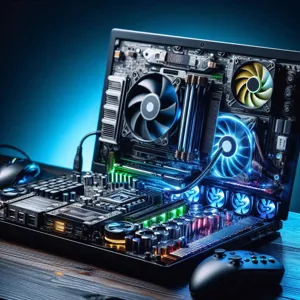
Choosing the right environment for gaming is crucial in maintaining your laptop’s optimal temperature, especially during those marathon gaming sessions. A well-ventilated space not only enhances your gaming experience but also protects your hardware from overheating. Start by selecting a location that is free from direct sunlight; the sun’s rays can raise the ambient temperature significantly, making it harder for your laptop’s cooling system to do its job.
Consider gaming in a room with air conditioning or a fan to keep the air circulating. A cool environment can make a noticeable difference in your laptop’s performance and longevity. If air conditioning isn’t an option, open windows or use portable fans to create airflow, ensuring that the hot air generated by your gaming sessions doesn’t get trapped around your laptop.
Additionally, avoid gaming on soft surfaces like beds or couches, as these can obstruct airflow and trap heat. Instead, opt for a hard, flat surface that allows your laptop’s fans to function efficiently. There are also cooling pads available that provide extra ventilation and can be a game-changer for intense gaming sessions. By thoughtfully selecting your gaming environment, you can significantly reduce the risk of overheating and keep your gaming laptop performing at its best, allowing you to focus on what truly matters—winning those epic battles!
4. Proper Laptop Positioning for Optimal Airflow
When it comes to maintaining the coolness of your gaming laptop, proper positioning is just as crucial as the hardware and software optimizations. The way you place your laptop can significantly impact its airflow and heat dissipation, ensuring that you can game for hours without throttling or overheating.
Start by placing your laptop on a hard, flat surface. Soft surfaces like beds or couches can block ventilation fans and restrict airflow, leading to increased temperatures. Instead, opt for a sturdy desk or table that allows your laptop to breathe. If you find yourself gaming on the go or in a variety of settings, consider investing in a portable laptop stand. These stands elevate your device, creating space beneath for airflow and helping to prevent the heat from getting trapped.
Additionally, pay attention to the orientation of your laptop. Make sure the vents are not obstructed by any items, such as books or papers, that may accumulate around your setup. Keeping at least a few inches of space around the laptop helps maintain proper airflow. You can also experiment with angling your laptop slightly to encourage heat to escape more efficiently.
Incorporating these simple positioning strategies will not only enhance your gaming experience but also extend the lifespan of your laptop. A well-ventilated laptop is a happy laptop, and by taking these steps, you’ll ensure that your gaming sessions remain uninterrupted and cool, no matter how intense the action gets.
5. Using a Cooling Pad: Do They Really Work?
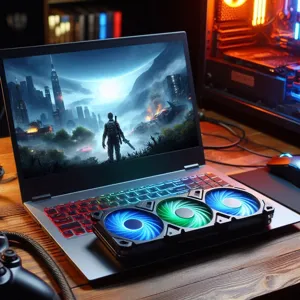
When it comes to keeping your gaming laptop cool, the topic of cooling pads often arises, raising the age-old question: do they really work? The short answer is yes, they can make a noticeable difference in your laptop’s temperature management. Cooling pads are specifically designed to provide additional airflow and dissipate heat generated during intense gaming sessions.
Imagine sinking into an immersive gaming experience, your favorite title loading up as you gear up for battle. However, as the action heats up, so does your laptop. Enter the cooling pad. These devices typically feature one or more fans positioned strategically to enhance ventilation beneath your laptop. By elevating your device off of flat surfaces, a cooling pad also allows air to circulate more freely, reducing the risk of overheating.
To illustrate their effectiveness, consider this: many gamers report a drop of several degrees Celsius in their laptop temperatures after implementing a cooling pad. This can be crucial when you’re pushing your hardware to its limits with high-resolution graphics and demanding gameplay. Not only do cooler temperatures help maintain performance, but they also extend the lifespan of your laptop’s components, reducing the likelihood of hardware failure.
However, it’s essential to choose the right cooling pad for your gaming setup. Look for models that offer adjustable fan speeds, ergonomic designs, and compatibility with your laptop’s size. While they may not replace the need for regular cleaning and maintenance, cooling pads serve as an excellent supplementary tool in your arsenal against heat. So, if you’re serious about gaming and want to preserve the integrity of your machine, investing in a quality cooling pad could be a game-changer.
6. Regular Cleaning and Maintenance Tips
Keeping your gaming laptop cool is essential for maintaining peak performance and extending its lifespan, and one of the most effective ways to achieve this is through regular cleaning and maintenance. Dust and debris are the arch-nemeses of any high-performance machine, as they can accumulate in the vents and fans, obstructing airflow and leading to overheating.
Start by creating a cleaning schedule—once every few months is a good rule of thumb. When it’s time for a cleaning session, make sure to power down your laptop and unplug it. Use a can of compressed air to blow out dust from the vents, fans, and keyboard. Hold the can upright and use short bursts to avoid moisture buildup. This will help restore airflow and prevent overheating during intense gaming sessions.
Additionally, don’t forget to clean the laptop’s exterior. A microfiber cloth lightly dampened with a mixture of water and isopropyl alcohol can work wonders, giving your laptop a fresh look while removing fingerprints and grime that can trap heat.
Beyond cleaning, consider applying thermal paste to the CPU and GPU if you’re comfortable disassembling your laptop. Over time, thermal paste can dry out and lose its effectiveness, leading to higher temperatures. Reapplying this thermal interface material can significantly improve heat dissipation, ensuring your components stay cool under pressure.
Finally, keep an eye on the placement of your gaming laptop. Make sure it’s on a hard, flat surface that allows for adequate airflow. Avoid using it on soft surfaces like beds or couches, which can block vents and cause heat buildup. By incorporating these regular cleaning and maintenance tips into your routine, you’ll help your gaming laptop beat the heat and keep your gaming experience smooth and enjoyable.
7. Managing In-game Settings to Reduce Heat
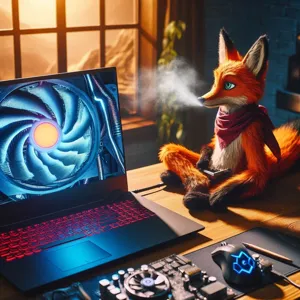
When it comes to keeping your gaming laptop cool, one of the most effective strategies lies in managing your in-game settings. Many gamers are eager to crank every graphical option to the max, eager to experience every stunning detail and realistic shadow. However, this can significantly increase the workload on your laptop’s GPU and CPU, leading to higher temperatures and potential thermal throttling.
To combat this, consider adjusting your graphics settings to strike a balance between performance and visual quality. Start by lowering the resolution slightly or tweaking texture quality; even small changes can lead to a noticeable drop in heat generation. Additionally, turning off or reducing advanced features like anti-aliasing, ambient occlusion, and V-Sync can further ease the load on your system.
Don’t forget about the in-game frame rate settings. While it may be tempting to aim for high frames per second (FPS), capping your FPS can prevent your laptop from overheating. Most games allow you to set a maximum frame rate, helping to reduce the strain on your hardware during intense gaming sessions.
Furthermore, consider utilizing built-in game modes or presets that optimize performance without sacrificing too much on aesthetics. Many modern titles come equipped with performance-oriented modes designed to run smoothly even on less powerful hardware—perfect for keeping temperatures in check.
Lastly, keeping an eye on your laptop’s internal temperature using monitoring software can provide valuable insights. If you notice your device heating up during specific games, it may be time to revisit those settings and make further adjustments. By effectively managing your in-game settings, you not only enhance your gaming experience but also safeguard the longevity and performance of your gaming laptop.
8. Upgrading Your Laptop’s Cooling System
When it comes to maintaining optimal performance during those intense gaming sessions, upgrading your laptop’s cooling system can be a game-changer. Many gaming laptops come equipped with standard cooling solutions, but as you push your machine to its limits with high-resolution graphics and demanding gameplay, these systems can struggle to keep your laptop at a safe operating temperature.
One of the most effective upgrades you can make is to replace the thermal paste on your CPU and GPU. Over time, the thermal paste that helps transfer heat away from these critical components can degrade, leading to higher temperatures and potential thermal throttling. By applying a high-quality thermal paste, you can significantly improve heat dissipation, allowing your components to run cooler and more efficiently.
Additionally, consider investing in a laptop cooling pad. These external devices often feature multiple fans designed to enhance airflow beneath your laptop, helping to draw heat away from the chassis. Many models are portable and lightweight, making them easy to transport, and they can provide a significant boost in cooling, especially during those marathon gaming sessions.
If you’re feeling particularly ambitious, you might even explore internal upgrades such as adding additional fans to your laptop’s cooling system, if your model allows for it. This can create a more robust airflow pathway, further decreasing the chances of overheating.
Lastly, ensure that your laptop’s ventilation ports are clean and unobstructed. Dust and debris can accumulate over time, blocking airflow and reducing cooling efficiency. Regularly cleaning these areas will help maintain optimal performance and prolong the life of your gaming laptop.
By upgrading your laptop’s cooling system, you not only enhance your gaming experience but also safeguard your hardware investment, ensuring that you can play at your best without the worry of overheating.
9. Thermal Paste: When and Why You Should Replace It
When it comes to maintaining the optimal performance of your gaming laptop, one often-overlooked component is the thermal paste that sits between the CPU and GPU and their respective heatsinks. Over time, thermal paste can dry out or degrade, leading to inefficient heat transfer, which can cause your laptop to overheat during those intense gaming sessions.
So, when should you consider replacing it? If you notice your laptop running hotter than usual, or if the fans are constantly revving up to high speeds even during less demanding tasks, it might be time for a thermal paste refresh. Typically, it’s recommended to replace the thermal paste every couple of years, but this can vary depending on usage patterns and the quality of the original paste.
Why is it crucial? Fresh thermal paste can significantly improve thermal conductivity, allowing heat to dissipate more effectively. This leads to lower temperatures for your CPU and GPU, resulting in better performance and longevity for your machine. Additionally, a cooler laptop means quieter operation; no one enjoys the constant drone of fans working overtime.
Replacing thermal paste isn’t as daunting as it sounds. With a bit of research and the right tools, you can tackle this maintenance task yourself. However, if you’re not comfortable opening up your laptop, seeking professional help is a wise choice. Ensuring your gaming laptop is well-maintained and cool will enhance your overall gaming experience, keeping you immersed in your virtual worlds without the worry of overheating.
10. Monitoring Temperature with Software Tools
Keeping your gaming laptop cool is essential for maintaining performance, prolonging its lifespan, and enhancing your overall gaming experience. One of the most effective ways to manage your laptop’s temperature is by utilizing temperature monitoring software tools. These programs can provide real-time insights into your laptop’s internal temperatures, allowing you to take timely action to prevent overheating.
There are several reliable software options available, such as HWMonitor, MSI Afterburner, and Core Temp, which can display the temperatures of various components, including the CPU and GPU. By regularly checking these readings, you can identify when things start to heat up. For instance, if you notice that your CPU is consistently hovering around 90°C, it’s a clear sign that your laptop needs immediate cooling intervention.
Many of these tools also allow you to set up alerts, so you’ll be notified if temperatures exceed a certain threshold. This feature can be particularly useful during long gaming sessions. Additionally, some software can facilitate fan speed adjustments, enabling you to increase airflow and reduce heat buildup on demand. When used effectively, monitoring software can empower you to take proactive measures, such as closing unnecessary applications or increasing fan speeds, before heat becomes an issue.
Moreover, understanding your laptop’s thermal performance can help you optimize your gaming setup. You might discover patterns in temperature spikes related to specific games or graphics settings, allowing you to adjust your play style accordingly. By actively monitoring your laptop’s temperature with these tools, you can ensure that your gaming rig remains cool, enabling you to focus on what matters most—immersive gameplay without the distractions of overheating.
11. The Role of Hardware in Heat Generation
When it comes to gaming laptops, understanding the role of hardware in heat generation is crucial for maintaining optimal performance during those intense gaming sessions. High-performance components like the CPU and GPU are typically the biggest culprits when it comes to heat production. These powerful processors work tirelessly to render graphics, execute complex algorithms, and ensure a smooth gameplay experience, but this high level of activity generates significant heat.
For instance, a gaming laptop equipped with a top-tier graphics card, such as the NVIDIA GeForce RTX series, can push thermal limits, especially during graphically demanding titles. Similarly, multi-core CPUs designed for gaming and multitasking can heat up quickly, particularly if they are overclocked for enhanced performance. In essence, the more power your hardware needs to deliver, the more heat it produces.
Moreover, less efficient cooling solutions can exacerbate heat issues. Some laptops come with inadequate thermal management systems that struggle to dissipate this excess heat effectively. This might result in throttling, where the CPU and GPU automatically reduce their performance to cool down, ultimately affecting your gaming experience.
To mitigate these heat challenges, consider hardware specifications when choosing a gaming laptop. Look for models with robust cooling systems that feature multiple heat pipes, larger fans, and improved airflow designs. Additionally, opting for laptops with advanced thermal management technologies can help maintain optimal temperatures, allowing you to enjoy prolonged gaming sessions without the fear of overheating. By understanding the intrinsic relationship between hardware and heat generation, you can make informed choices that help keep your gaming laptop cool and your gameplay uninterrupted.
12. Best Practices for Gaming on the Go
When it comes to gaming on the go, keeping your laptop cool can be a challenge, but with the right practices, you can optimize your gaming experience and safeguard your device from overheating. Here are some best practices to consider:
**1. Choose the Right Environment:** Whenever possible, find a cool, well-ventilated space to set up your gaming session. Avoid direct sunlight or enclosed areas where heat can build up. If you’re outdoors, try to find shade or consider using a portable fan to circulate air.
**2. Use a Cooling Pad:** Investing in a high-quality cooling pad can significantly reduce your laptop’s temperature. These pads come equipped with fans that help dissipate heat, providing additional airflow to your device. Look for one that fits your laptop size and offers adjustable fan speeds for maximum effectiveness.
**3. Manage Your Settings:** Adjusting your in-game graphics settings can help reduce the workload on your GPU and CPU, leading to lower temperatures. Lowering the resolution or disabling resource-heavy features like shadows and anti-aliasing can lessen the strain on your hardware, allowing for a cooler gaming experience.
**4. Close Background Applications:** Before diving into your gaming session, take a moment to close any unnecessary applications running in the background. Programs that consume CPU and RAM can lead to overheating, so keeping your system lean will help maintain optimal performance.
**5. Keep Your Laptop Clean:** Dust and debris can accumulate in your laptop’s vents, obstructing airflow and causing overheating. Regularly clean your device by using compressed air to blow out dust from the vents and fans, promoting better cooling efficiency.
**6. Take Breaks:** While it might be tempting to go on marathon gaming sessions, frequent breaks can help prevent overheating. Not only do breaks give your laptop a chance to cool down, but they also provide you a moment to stretch and refresh your mind for better gameplay.
**7. Monitor Temperatures:** Consider using software tools to keep an eye on your laptop’s temperature. Programs like HWMonitor or MSI Afterburner can provide real-time data on the temperature of key components, allowing you to take action before your laptop reaches critical levels.
By integrating these best practices into your gaming routine, you can enjoy long hours of gameplay without the worry of overheating. Keeping your gaming laptop cool while on the go ensures that your hardware remains in top shape, allowing you to focus on what truly matters: the game!
13. Hydration and Breaks: Keeping Yourself Cool
While it’s easy to focus solely on your gaming laptop’s temperature, it’s just as crucial to consider your own well-being during those intense gaming sessions. Hydration and regular breaks play a vital role in maintaining not only your physical comfort but also your mental sharpness, which can contribute to a more enjoyable gaming experience.
First and foremost, keep a water bottle within reach. Staying hydrated is essential, especially during long hours of gameplay. Dehydration can lead to fatigue, headaches, and decreased concentration, all of which can negatively impact your gaming performance. Aim to sip water regularly rather than waiting until you feel thirsty. Consider infusing your water with slices of citrus or refreshing cucumber to make hydration more enjoyable.
In addition to hydration, don’t underestimate the power of taking breaks. Prolonged gaming can lead to fatigue and decreased focus, making you more susceptible to errors or poor decision-making in-game. Set a timer to remind yourself to take a five to ten-minute break every hour. During this time, stretch your legs, do some light exercises, or simply step away from the screen to give your eyes a rest. This not only cools your body down but also allows your mind to reset and regroup.
Combining hydration with regular breaks creates a balanced approach to gaming. You’ll not only feel cooler and more comfortable physically, but you’ll also maintain a sharper, more alert mindset, allowing you to perform at your best. So, the next time you settle in for an epic gaming marathon, make sure to keep your hydration station stocked and schedule those essential breaks—your body and your gaming skills will thank you!
14. Conclusion: Maintaining Longevity and Performance
In conclusion, maintaining the longevity and performance of your gaming laptop is not just about preventing overheating; it’s a holistic approach that encompasses regular maintenance, strategic usage, and an understanding of your device’s capabilities. By adopting the simple tips outlined in this post, such as ensuring proper ventilation, using cooling pads, and monitoring your internal temperatures, you can significantly extend the lifespan of your hardware while enhancing your gaming experience.
Remember, a cooler laptop doesn’t just mean better performance during those intense gaming sessions; it also leads to fewer hardware issues, reduced wear and tear, and overall efficiency. This means more hours of uninterrupted gameplay and less time spent on repairs.
Additionally, cultivating good habits—like cleaning dust from vents, avoiding gaming on soft surfaces, and being mindful of ambient temperatures—will pay dividends in the long run. So, take the time to care for your gaming laptop, and you’ll be rewarded with a reliable companion that can keep up with your gaming passion for years to come. Now, gear up, keep it cool, and dive into your next gaming adventure with confidence!
15. Additional Resources for Further Reading
When it comes to maintaining optimal performance and longevity for your gaming laptop, staying informed is key. Fortunately, there are numerous resources available that delve deeper into the intricacies of laptop cooling solutions, thermal management strategies, and the latest in gaming technology.
1. **Online Forums and Communities**: Websites like Reddit, Tom’s Hardware, and the Linus Tech Tips forums offer a wealth of collective knowledge from fellow gamers and tech enthusiasts. These platforms allow you to engage in discussions, ask questions, and share experiences regarding cooling techniques, product recommendations, and troubleshooting tips.
2. **YouTube Channels**: Visual learners can benefit from the plethora of YouTube channels dedicated to gaming hardware and maintenance. Channels like JayzTwoCents and Gamers Nexus provide in-depth reviews, DIY tutorials, and valuable insights into keeping your gaming rig cool. Watching these experts at work can give you practical tips that you can implement right away.
3. **Manufacturer Websites**: Always a reliable source, your laptop manufacturer’s website often houses detailed guides and FAQs about your specific model. They may provide recommendations for cooling pads, thermal paste replacements, and even firmware updates that can enhance your laptop’s performance.
4. **Cooling Product Reviews**: Websites that specialize in tech reviews, such as PCMag or CNET, offer comprehensive evaluations of various cooling accessories like laptop cooling pads, external fans, and even liquid cooling systems designed for mobile devices. Reading these reviews can help you make informed decisions when investing in additional cooling solutions.
5. **Gaming Blogs and Magazines**: Publications like Edge and Game Informer often feature articles that touch on hardware optimization, including tips for cooling your system while maximizing performance. Subscribing to these can keep you updated on the latest trends in gaming technology.
By exploring these resources, you can equip yourself with the knowledge necessary to tackle heat-related issues effectively. Whether you’re looking to fine-tune your current setup or explore new cooling technologies, there’s a wealth of information out there to help you keep your gaming laptop performing at its best, even during the most intense gaming sessions.
In conclusion, ensuring your gaming laptop stays cool is essential for maintaining performance and prolonging its lifespan. By implementing the tips we’ve shared—from optimizing airflow and investing in a cooling pad to regular maintenance and mindful gaming habits—you can create a more enjoyable and uninterrupted gaming experience. Remember, a cooler laptop not only enhances your gameplay but also protects your investment. So, the next time you dive into an intense gaming session, rest easy knowing you’ve taken the necessary steps to beat the heat. Happy gaming, and may your adventures be both thrilling and cool!


